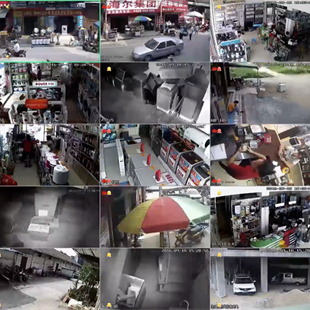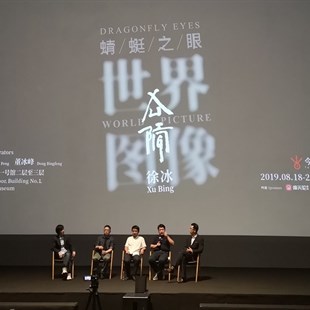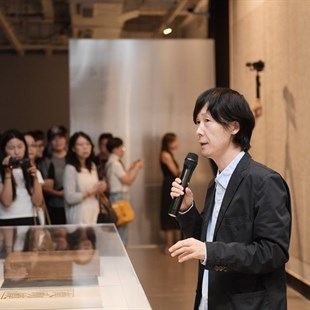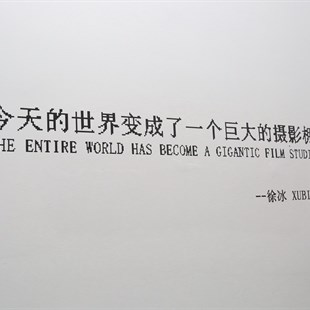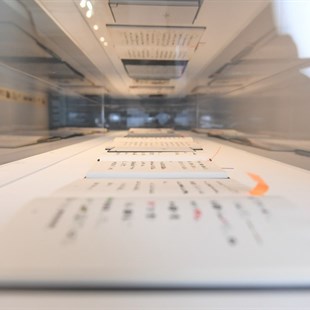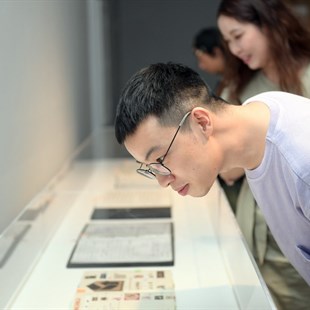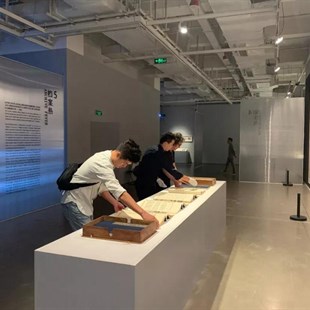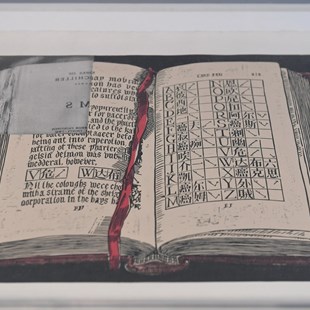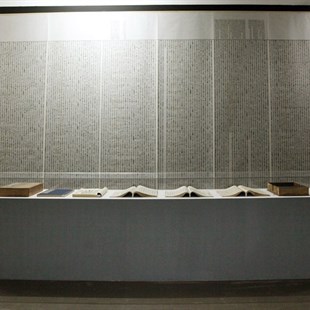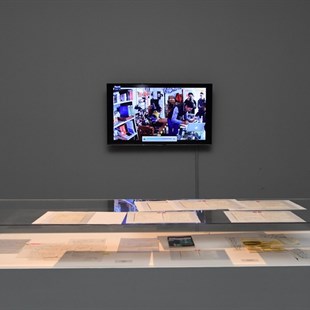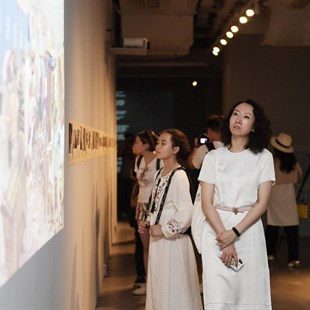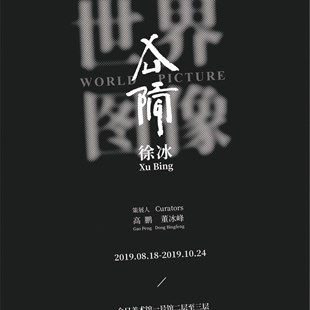
Moving images, the exhibition and Xu Bing constitute a mysterious power that allows viewers to jump into the abyss of the world of images.
When things with energy collide with each other, the result is often the secret of attracting the outside world in. Following his Phoenix project in 2010, Mr. Xu Bing and the Today Art Museum conducted a second collaboration to launch the “World Picture: Xu Bing Dragonfly Eyes”, which is also the latest testimony to his return to the country after nearly a decade. It seems that around the exhibition of Xu Bing’s Dragonfly Eyes, a perfect narrative is given to the history of the art and the present. This exhibition presents three levels of perception. The first level is to feel the film Dragonfly Eyes. The second part is the documentation exhibition area; the third part is to understand Xu Bing and his art’s nine “keywords” so as to deeply interpret the film Dragonfly Eyes and Xu Bing’s artistic creation process.
Mixing the Genuine with the Fictional: Dragonfly Eyes
In order to show the film Dragonfly Eyes, a new “Dragonfly Cinema” was created on the second floor of the Today Art Museum. Dragonfly Eyes is the first artistic video work directed by Xu Bing, which is 81 minutes long. The film was co-written by Zhai Yongming and Zhang Hanyi. Matthieu Laclau and Zhang Wenchao served as joint editors. Li Danfeng served as a sound director. Yoshihiro Hanno is the original music producer.
What kind of work is Dragonfly Eyes? After his creation, he won a large number of film festival awards. This work has not been widely publicized, and only a few fragments have appeared in some exhibitions so the public is full of infinite curiosity. This film tells a “weird” love story through editing public monitoring images published in the real life and mixed with experimental art. The techniques, plots and concepts of this film need to be viewed from an artistic level. If you only watch it as a movie, you might easily miss the fun or be short-sighted.
Dragonfly Eyes uses all the ready-made surveillance images released in the cloud space over the last few years. The artist observes the world with compound eyes like a dragonfly in front of a large amount of open materials. However, how to display the images of different places, different times, different characters and different events in front of the viewer? It becomes necessary to connect them in a disorderly plot. Perhaps the artist believes that these records of occasional strange scenes make it easier for viewers to return to the concern of a world that exists for the self. The images presented in the plot break the visual attribution of the old images to a certain extent. The former images are from the artist and belong to the public; while the images of the works are from the public but belong to the artist. The artist uses the image world through surveillance to turn the audience into a legitimate “peeping Tom”, which is imposed on the audience through the plot.
As an important connection point, the plot highlights the artist’s understanding of the comprehensive expression of the work. In the story, the heroine who entered the temple to practice Buddhism due to her illness, she went to work in a dairy farm after leaving the temple, but her male colleague fell in love with her. She left the dairy farm and had a number of jobs, and finally had plastic surgery to become an internet celebrity anchor. Her colleague has been secretly tracking her, but after he lost the clues, he tried to love her by cloning her looks and life experiences. He became a woman after plastic surgery, and re-experienced the life that the heroine had lived and worked, and finally returned to the temple where the heroine had been before.
This is a story about love. When the man cannot find the love of the woman, the man has to turn himself into the woman he loves step by step. This is a love story full of extreme behaviors, but it shows the bondage of love to people. The human beings within industrial civilization, how to express the suppression love, need to find a way out from the potential impact of social psychology and personal psychology. The film of Dragonfly Eyes uses the most authentic materials, but it constructs the most realistic illusion, so that it mixes the genuine with the fictional.
Viewing the Old from a New Perspective: the Documentation Exhibition Area
After watching the Dragonfly Eyes, the documentation exhibition area was specially planned on the third floor of the museum. While focusing on the concept of the artist’s Dragonfly Eyes and the behind-the-scenes story, it has tried the curatorial method of relevance as a comparison to present in the whole exhibition to establish a dialogue that combines a documentary and visual display. Xu Bing’s artistic creation has a strong logical change. In his works, he will always highlight the fission of the core concepts. He always finds coordinates in his own time and releases his unique artistic creations. From the historical perspective, the documentation exhibition area re-strung the logic of the related works. Xu Bing’s work shows people a process of creation rather than the presentation of results. Detailed production records, meticulous manuscripts, and thoughtful works all make people feel in awe of art.
“Viewing the old from the new perspective” is also an interpretation of the Dragonfly Eyes. From Xu Bing’s previous works, his original work, such as An Analysis of a Reflection of the World— The Final Volume of The Century, is an example. The best effort has become a seemingly reasonable existence, so that these strange symbols are accepted. But Dragonfly Eyes develops in the another direction, as it uses the real images that people often see as the materials, but constitutes a weird story to let the truth disappear, making it funny rather than a real story. Through the creation of an illusion with the real materials, the creation turns from “mixing the false with the genuine” to the present “mixing the genuine with the fictional.”
One of the purposes of the documentation exhibition is to restore the significance behind each work, so that the path of spectating becomes sincere and clear. The display of the documentation exhibition area is a supplement for the audience as the brief descriptions cannot really attract the audience’s attention, especially compared to the real shocking senses presented by Xu Bing’s film, this way seems to be difficult to comprehend by unfamiliar audiences.
Unlocking the Door with a Bolt: Nine “Keywords”
Xu Bing is an artist with an individualistic art history. The complete artistic creation process, the presentation of diversified styles of works, the rich texts of his case studies, the influences of his art on a global scale, etc., do not just constitute the recognition of his contribution to art, but it further evidences that the artist can use more distinct and specified artistic concepts to affect more areas.
The curatorial team of this exhibition used nine “keywords” to allow the viewers to understand the past and future of Xu Bing’s art more accurately. This third part is also the most powerful part of this exhibition. The nine “keywords” of “World Picture” can be divided into three categories and sources: First, the original artistic concepts in Xu Bing’s artistic career; Second, more frequent problems and theoretical viewpoints appearing in the comments on Dragonfly Eyes; Third, the specific concepts and methods in the production process of Dragonfly Eyes, the “keywords” of these three categories are the relationship of mutual association and dialogue. At the same time, it will also showcase the key concepts and representative works of Xu Bing’s previous art developments, and further explore the artistic propositions and formal experiments of his latest work Dragonfly Eyes. For the overall understanding of Xu Bing’s artistic work, it gains a more essential grasp and experience of the inner context.
The nine keywords are like the nine latches that open Xu Bing’s world of pictures. The nine keywords are: Plurality, Social Energy, Characters and Images, Defamiliarization, Archive Fever, Body, Non-form, Portrait Rights, and Live Streaming and Editing. These nine keywords constitutes the necessary way to understand Xu Bing, giving the viewer a comprehensive interpretation of the direction, but too many conceptual displays might make the concept of art become dispelled.
The World Picture and Xu Bing’s Dragonfly Eyes exhibition imply the great charm of the image medium in artistic creations. It also shows once again what kind of visual mind we need to face for the future image world in the art world full of true and false expressions.




